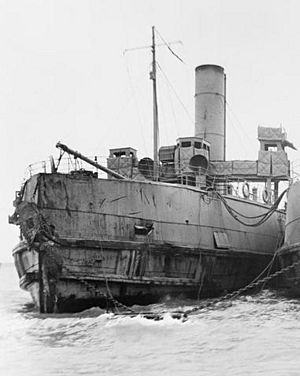SS Royal Daffodil facts for kids

Daffodil at Dover soon after the Zeebrugge Raid
|
|
Quick facts for kids History |
|
|---|---|
| United Kingdom | |
| Name |
|
| Owner |
|
| Builder | Robert Stephenson and Company, Newcastle upon Tyne. |
| Yard number | 101 |
| Launched | 20 April 1906 |
| Christened |
|
| Completed | June 1906 |
| In service | 1906 |
| Out of service | 1938 |
| Identification | UK Official Number 123974 |
| Fate | Scrapped 1938 |
| General characteristics | |
| Displacement | 482 GRT |
| Length | 159 ft (48.46 m) |
| Depth | 8 ft 6 in (2.59 m) |
| Propulsion | Twin screw, triple expansion, by D Rollo & Sons. |
| Capacity | 1,735 passengers |
The SS Royal Daffodil was a special ferry that sailed on the River Mersey in England. She was built in 1906 and worked for many years. Originally, her name was just Daffodil.
She became famous for her brave actions during World War I. Because of her important role in a daring mission, she was later renamed Royal Daffodil. She was finally taken apart for scrap in 1938.
Contents
A Ship's Amazing Journey
Early Days as a Ferry
The ship was built by Robert Stephenson & Sons. She was finished in June 1906. Her job was to be a Mersey Ferry. She carried passengers between the cities of Liverpool and Wallasey. She could carry up to 1,735 people.
Becoming a War Hero
In 1918, during World War I, the Daffodil was needed for war service. She was taken over by the navy and became HMS Daffodil. Her sister ship, the Iris, also joined the navy as HMS Iris II.
Both ferries were prepared for a secret mission. This mission was called the Zeebrugge Raid. The goal was to block a port in Belgium that German submarines were using. The ships were stripped of their furniture. They also had strong armor added to protect them. The ferries were chosen because they could sail in shallow water. They also had a special "double hull" design. This made them tougher.
The Zeebrugge Raid
The Daffodil had a very important job in the raid. She carried a team of sailors who were going to use explosives. These sailors were called "C" Company. Their job was to blow up important targets.
On April 23, 1918, both the Iris and the Daffodil were pulled across the English Channel. They were towed by a larger ship called HMS Vindictive. During the attack, the Daffodil was hit by two shells. Even with damage, she managed to hold the Vindictive against a wall. This was crucial for the mission. Sadly, one crew member on the Daffodil died during the raid.
A Hero's Welcome Home
After the dangerous mission, the Iris and Daffodil returned home. On May 17, 1918, they arrived back at the River Mersey. People cheered for them like heroes! After getting repairs, both ships went back to work as ferries.
The Royal Daffodil Years
Because of her bravery in the raid, King George V gave the ship a new name. She was renamed Royal Daffodil. She still had marks from the battle on her hull.
In 1934, the Royal Daffodil was sold to a new company. She then worked on different routes, taking people on excursions. In 1936, another company took over. Finally, in 1938, the Royal Daffodil was sold for scrap. This means she was taken apart in Belgium.

